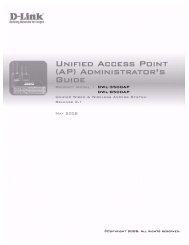Product Manual
Product Manual
Product Manual
You also want an ePaper? Increase the reach of your titles
YUMPU automatically turns print PDFs into web optimized ePapers that Google loves.
Parameter Description<br />
DES-3526 / DES-3526DC Fast Ethernet Layer 2 Switch<br />
Time Interval Select the desired setting between 1s and 60s, where "s" stands for seconds. The<br />
default value is one second.<br />
Record Number Select number of times the Switch will be polled between 20 and 200. The default<br />
value is 20.<br />
64 The total number of packets (including bad packets) received that were 64 octets in<br />
length (excluding framing bits but including FCS octets).<br />
65-127 The total number of packets (including bad packets) received that were between 65<br />
and 127 octets in length inclusive (excluding framing bits but including FCS octets).<br />
128-255 The total number of packets (including bad packets) received that were between<br />
128 and 255 octets in length inclusive (excluding framing bits but including FCS<br />
octets).<br />
256-511 The total number of packets (including bad packets) received that were between<br />
256 and 511 octets in length inclusive (excluding framing bits but including FCS<br />
octets).<br />
512-1023 The total number of packets (including bad packets) received that were between<br />
512 and 1023 octets in length inclusive (excluding framing bits but including FCS<br />
octets).<br />
1024-1518 The total number of packets (including bad packets) received that were between<br />
1024 and 1518 octets in length inclusive (excluding framing bits but including FCS<br />
octets).<br />
Show/Hide Check whether or not to display 64, 65-127, 128-255, 256-511, 512-1023, and<br />
1024-1518 packets received.<br />
Clear Clicking this button clears all statistics counters on this window.<br />
View Table Clicking this button instructs the Switch to display a table rather than a line graph.<br />
View Line Chart Clicking this button instructs the Switch to display a line graph rather than a table.<br />
MAC Address<br />
This allows the Switch's dynamic MAC address forwarding table to be viewed. When the Switch<br />
learns an association between a MAC address and a port number, it makes an entry into its forwarding<br />
table. These entries are then used to forward packets through the Switch.<br />
To view the MAC Address forwarding table, from the Monitoring menu, click the MAC Address<br />
link:<br />
164

















